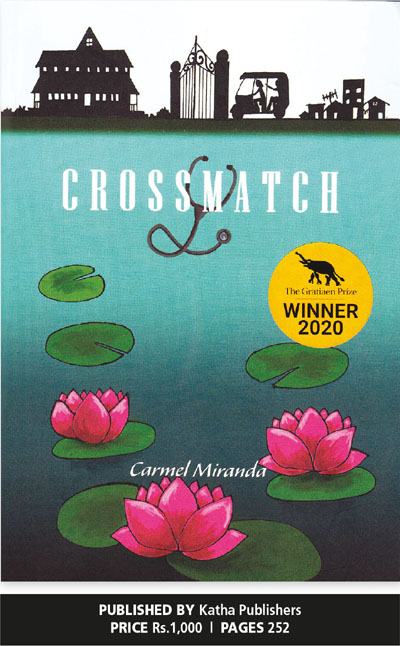BOOKRACK
By Vijitha Yapa
Novels written by medical practitioners are rare in Sri Lanka. The common belief is that since they’re so busy making money, doctors have precious little time to write anything except prescriptions, which require the specialised knowledge of pharmacists to decipher!
There are a few exceptions to this perception however, such as forensic expert Prof. Ravindra Fernando who has written several books. One of them is titled ‘Murders at the Vicarage – The Matthew Peiris Case.’ It is a well-researched book based on facts and not a novel.
As such, Dr. Carmel Miranda’s debut novel Crossmatch – winner of the prestigious 2020 Gratiaen Prize – is an incredible achievement.
Doctors in the literary field are many but the best known is Sir Arthur Conan Doyle whose Sherlock Holmes novels are legendary. The keen methods of observation applied by Holmes and his famous phrase “Elementary, my dear Watson” will resonate in the minds of readers.
Miranda therefore, is an exception. That classic whodunit The Murder of Roger Ackroyd came to mind as I read this author’s maiden offering to the end. And it was gripping, for she has created a scenario very much like that of an Agatha Christie page turner.
But there is no policeman or quirky detective in this story. Instead, a medical student named Lotus is the narrator and she takes us along with her through the book. This tale revolves around her ingenious unravelling of the mystery that surrounds the death of a young boy who had run across the street and was knocked down by a passing vehicle.
In every chapter, it’s Lotus who steals the limelight. The dead young boy Anil was the nephew of her aunt’s driver. The latter’s plea to try and find out what actually happened to him leads Lotus deeper into the mystery.
Her observations and conclusions are what matter most; and like Sherlock Holmes, her every action results in unravelling successive layers of the mystery.
It seems to be a hit-and-run accident but a careful study reveals more and the reader is held in suspense by the author’s narrative skills. A cut on Anil’s stomach turns out to be an incision from where one of his kidneys had been removed. The mobile phone belonging to him becomes a treasure trove of information as the numbers in it provide clues for further investigation.
One problem with new authors is that there is plenty of dialogue but very little description of the characters. However, Carmel’s descriptive skills are extraordinary. For her, it’s a case of details ranging from paper thin moustaches to a character being described as someone who is as “bald as a basketball.”
As a result of this expansive and vivid lingo, the reader gets a clear picture of what’s happening and which characters are to play major roles. The narrator speaks of a girl who has “six ear piercings and changes hairstyles more frequently than she changes her toothbrush.”
Her description of a midwife is another example: “… a witch-like crone with a bushy unibrow, protruding incisors and a voice like an ambulance siren.” And her asides are also heavy with meaning. After seeing about 10 pregnant women in a maternity ward, she says she didn’t know that there were so many expectant mothers in Colombo and wonders whether they had never heard of family planning!
Lotus’ visit to meet Anil’s mother who lives in a poorer part of the city that houses a shanty town also becomes an adventure as a neighbour tries to get the woman’s attention by shouting for the door to be opened. And the narrator wryly comments: “In this place, it seems normal to mind your neighbour’s business.”
The heroine of this story has an unusual name, which she says was given to her by her mother, and asks whether anyone has heard of a child being named after the hospital where she was born?
It seems as if the story is heading towards a conclusion when – based on the evidence provided by Lotus – some employees of the hospital are arrested by the police for selling kidneys to foreigners. But the story continues, which is why the journey to a conclusion reminds me of The Murder of Roger Ackroyd.
Unfortunately, the actual ending is quite weak and far too abrupt; and one hopes the author does not try to follow the threads here or any loose ends and attempt a sequel. It’s better to concentrate on a new plot and use this effort as a stepping stone to develop her talents.
Less detailed descriptions of medical activity would also have been welcome as this tome would have been a lot slimmer if large chunks of jargon had been deleted by an efficient editor.





